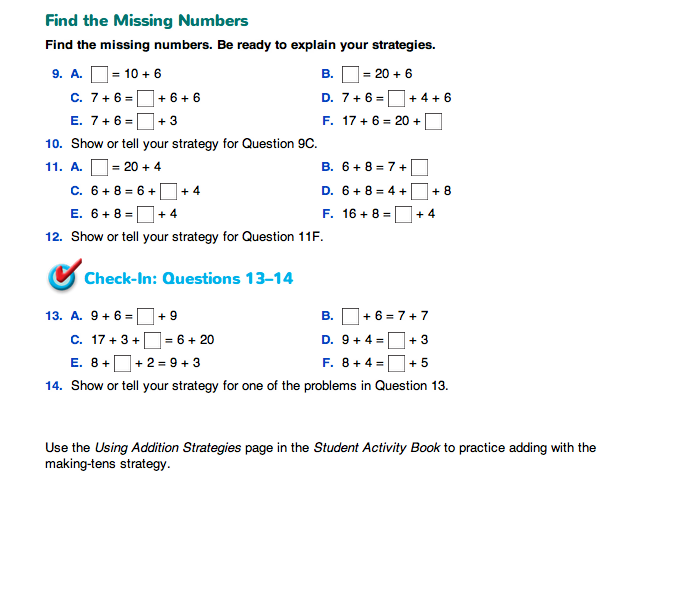Review the crucial concept that an equal sign expresses a relationship between numbers, display the number sentences, and ask:
- Is this number sentence true or false: 9 + 5 = 14? (True.)
- How do you know it is true? (Possible response: I know because when I connect 9 blue cubes to 5 red cubes, I have 14 cubes altogether.)
- Is this number sentence true or false: 14 = 9 + 5? Explain your thinking. (Possible answer: I think it's true, because I know in the problem before it, we added 9 to 5 and got 14, but I'm not sure because the answer looks like it's on the wrong side of the equal sign.)
- Do both sides of the equal sign show 14? (Yes, so it must be a true number sentence.)
- Is this number sentence true: 9 + 5 = 9 + 5? Why or why not? (Possible response: Yes, it's true because you are adding the same numbers on both sides of the equal sign.)
- Is this number sentence true or false: 9 + 5 = 10 + 4? Explain your thinking. (Possible response: True. Even though you are adding different numbers together, 9 + 5 is the same amount as 10 + 4. It's easy to solve because I know 9 is one less than 10, but 5 is one more than 4, so that makes the sums on the two sides the same.)
Use Questions 11 and 12 in the Student Guide to bring together the major ideas in the lesson. As students work on the problems, talk with them about their strategies and choice of tools to add and complete true number sentences.
- Can you give us an example of where you used a making-tens strategy in one of the problems in Question 11? (Possible response: In Question 11C, 6 + 8 = 6 +
 + 4, I can break the 8 into 4 + 4 and then add one of the fours to the 6 to make a ten. Then I add the other 4 to make 14 on one side of the equal sign. I know the equation on the other side of the equal sign must be 14, too. I can easily make a ten by adding 6 + 4 and then I just need 4 more in the box to make 14.)
+ 4, I can break the 8 into 4 + 4 and then add one of the fours to the 6 to make a ten. Then I add the other 4 to make 14 on one side of the equal sign. I know the equation on the other side of the equal sign must be 14, too. I can easily make a ten by adding 6 + 4 and then I just need 4 more in the box to make 14.)
- What number should be in the empty box in 16 + 8 =
 + 4 to make this a true number sentence? Tell how you decided. (Students should see that both sides of the equal sign must equal the same thing.)
+ 4 to make this a true number sentence? Tell how you decided. (Students should see that both sides of the equal sign must equal the same thing.)
Students will complete Check-In: Questions 13–14 independently. In Question 13, students solve problems that demonstrate their understanding of the equal sign and in Question 14, students explain the strategy they used to solve one of the problems. Before students begin their work refer them to the Math Practices page in the Reference section of the Student Guide. You can also display a copy of this page for all students to see. Ask students to follow along as you read Math Practices Expectations 2 and 5. Use the following discussion prompts to help students think about how to use these Expectations to guide their work in Question 14.
- Think about the problem 13 + 5 + 7. What strategy could you use to solve this problem? (Possible response: I could make a ten by adding 13 + 7 = 20. Then I could add 20 + 5 = 25.)
- If you were going to explain your strategy to another person, what would be important to include? (Possible response: It would be important to show all the steps in your thinking by showing the number sentences you use.)

Use Check-In: Questions 13–14 in the Student Guide and the corresponding Feedback Box in the Teacher Guide to note students' progress toward the following Expectations:
- E4.
- Recognize that the equal sign represents the relationship between two equal quantities.
- E5.
- Use strategies that apply the properties of addition to solve addition and subtraction problems (e.g., making tens, using tens, thinking addition, using doubles).
- MPE2.
- Find a strategy. I choose good tools and an efficient strategy for solving the problem.
- MPE5.
- Show my work. I show or tell how I arrived at my answer so someone else can understand my thinking.
The Workshop in Lesson 7 provides targeted practice with subtraction strategies.














